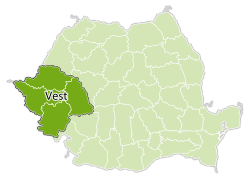Vest | |
|---|---|
Region | |
 | |
| Coordinates: 45°45′35″N21°13′48″E / 45.75972°N 21.23000°E | |
| Country | |
| Development Agency HQ | Timișoara |
| Largest city | Timișoara |
| Area | |
• Total | 32,028 km2 (12,366 sq mi) |
| • Rank | 6th |
| Population (2021 census) [1] | |
• Total | 1,668,921 |
| • Rank | 8th |
| • Density | 52.108/km2 (134.96/sq mi) |
| Ethnic groups | |
| • Romanians | 86.3% |
| • Hungarians | 6.7% |
| • Roma | 2.5% |
| • Germans | 1.4% |
| GDP | |
| • Total | $36.980 billion (2025) |
| Time zone | UTC+2 (EET) |
| • Summer (DST) | UTC+3 (EEST) |
| NUTS code | RO42 |
| HDI (2022) | 0.848 [3] very high · 3rd |
| Website | regiuneavest |
Vest (English: West) is a development region in Romania created in 1998. As with the other development regions, it does not have any administrative powers. Its primary functions are coordinating regional development projects and managing funds from the European Union.
